How to make your own Sourdough Starter, using simple ingredients with no special equipment, in just 6 days, that can be used in sourdough bread. Sourdough Starter is a “wild” yeast, made from flour, water and the wild yeast in the air around us- used to replace store-bought yeast. (Step-by-step VIDEO.)
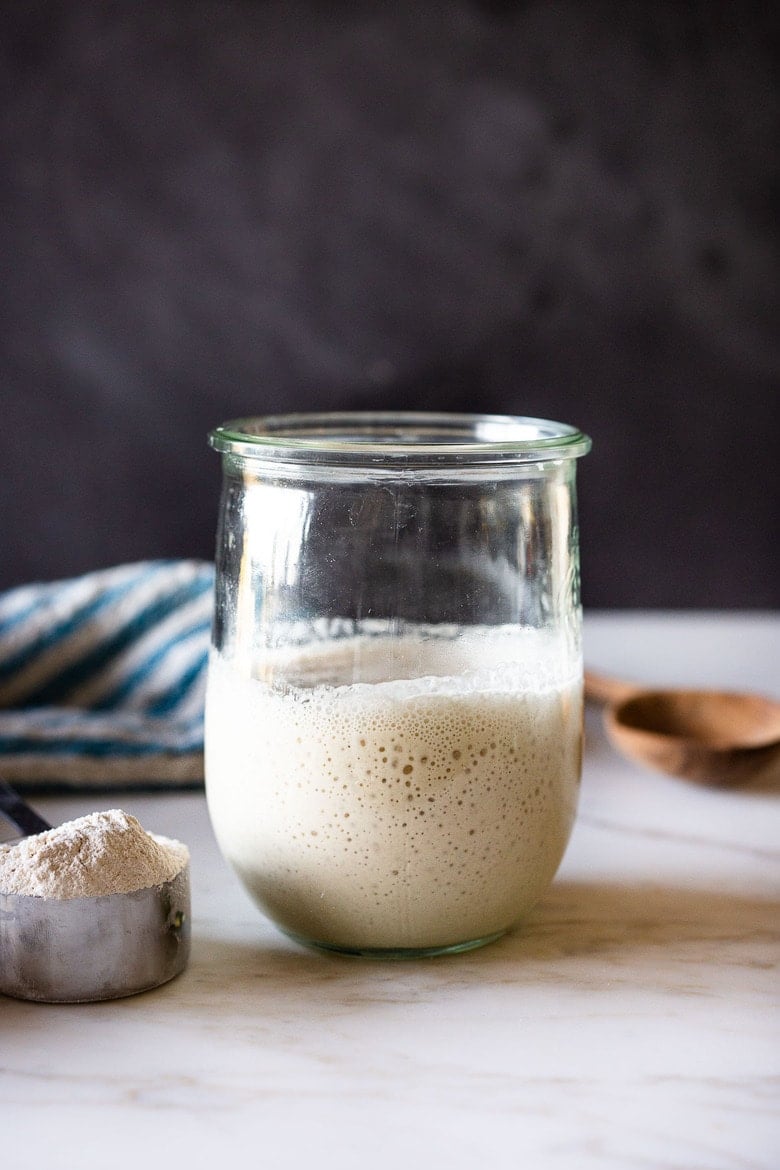 When you understand one thing through and through, you understand everything.~ Shunryu Suzuki
When you understand one thing through and through, you understand everything.~ Shunryu Suzuki
Hey friends, I’ve wanted to share this recipe for Sourdough Starter for years now, and with most of us being homebound, and without yeast available at the grocery stores, I thought this might be the perfect time to post it. As you know, we are in Santa Barbara for the winter, and one thing I didn’t even think to bring with me was my sourdough starter.
I made a fresh batch of starter last week, and baked a loaf of Sourdough Bread yesterday- and felt so much joy from this simple pleasure. The whole process honestly fills me with such wonder. How gloriously alive the world is! Plus there really is nothing like the smell of fresh bread to lift the spirits.
If you find yourself with a little more time on your hands, this might be the perfect opportunity to discover the joy of baking sourdough bread from your very own sourdough starter. You can also make baguettes, pizza dough, waffles, banana bread, pancakes,crackers, sourdough buns, sourdough tortillas and biscuits.
It’s truly incredible! The basic instructions were taught to me by a friend, who adapted it from Breadtopia and King Arthur Flour. I’ve taken liberties and further adapted, but both are great resources.
How to Make Sourdough Starter | 20-Min Video
***Don’t see the video? Allow 15-20 seconds to load it right here!*** (Still don’t see it? Check that your ad blocker is turned off.)
Fast forward to Specific Day by video time (using scroll bar underneath video)
- Day 1 Morning: :23
- Day 2 Morning: 4:10
- Day 3 Morning: 7:00
- Day 3 Evening: 9:12
- Day 4 Morning: 11:50
- Day 4 Evening: 13:37
- Day 5 Morning: 14:45
- Day 6 Evening: 16:50
- Day 6 Morning: 18:12
- Day 6 Evening: 20:10
What you’ll need
- Jar- A wide-mouth quart jar or a Weck’s 1-liter tulip jar.
- Flour – 5 lb bag of organic bread flour (plus 1 cup organic whole grain flour -optional)
- Water– filtered water, tap water, or mineral water (specifically, San Pellegrino, for the correct mineral ratio). Distilled water does not have enough minerals.
- Scale– using a kitchen scale is optional but handy.
- Thermometer– Knowing the temp of the starter using a thermometer is optional but handy!
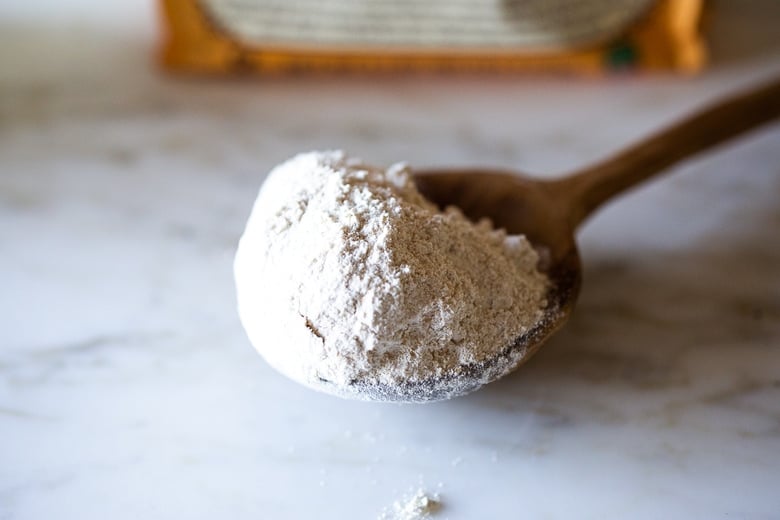
What is a Sourdough Starter?
- Think of sourdough starter as yeast. Only in this case, instead of buying a packet of yeast from the store, you are making your own living “wild yeast” by fermenting flour and water. That is it! ONLY 2 ingredients! Once it’s alive, it is like a very low-maintenance pet.
- You must feed it (stir in a mixture of flour and water) once a week to keep it healthy and happy. You know it’s happy when it bubbles. 😉 And YES, you can even name it.
- Some people believe that bread made with sourdough starter is actually better for you than bread made with yeast. Here and Here are a few articles to get you started on your own research. While I’m not sure if this is scientifically proven, I do know that bread made with sourdough starter, tastes infinitely better, feels easier to digest, and has more complexity and better texture, than bread made with commercial yeast. So if you are a bread lover- this is absolutely the way to go, as far as the quality of your finished bread.
What is Feeding?
- Feeding your sourdough starter is basically adding a mixture of flour and water to your existing starter, to keep it alive, happy, and nourished. Starter is full of wild yeasts that get hungry, just like we do. These yeasts need “food” -in this case, more flour, to stay healthy and active.
- How often you feed depends greatly on the temperature of your home. The starter will metabolize the flour more quickly in warm environments, and more slowly in cold environments (like the fridge). If you keep your starter in the fridge, you should only need to feed it once a week. If you keep it on the counter you may need to feed it 1-2 times daily, and sometimes more if you live in warmer climates.
Sourdough Starter (step-by-step instructions)
This recipe for Sourdough Starter takes 6 days (or up to 12 days if cold) and is very easy. This was the way I was taught and it always works for me. There are plenty of more complicated recipes out there, and I get it, if that is more your style – or you feel like completely nerding -out (a good thing, and this is the time!) dive in. Feed your fancy! Or watch the 20-minute Sourdough Video above!
Day 1: Staring in the morning or at night, using a wide-mouth quart jar, tulip jar, or Crock or Glass Measuring Cup , mix 1 cup whole grain flour (fluffed, spooned and leveled) -or 120 grams- with 1/2 cup (120 grams) filtered water using a fork (or chopstick) making sure you’ve incorporated all the dry flour.
Place the lid lightly on top (using the Weck jar is really handy here) or a wet towel to keep moisture in, or plastic wrap- and let sit at room temperature ( 70-ish degrees) on the kitchen counter for 24-48 hours. If you are not sure how warm it is, use a kitchen thermometer and check it a few hours later. See notes for TEMPERATURE.
TIP: For your first measuring – it is a good idea to weigh the flour using a kitchen scale so you get an idea of how it should feel. Do not weigh the cup. It should be like a thick paste. Thick like peanut butter. If you need to add a little more water to incorporate the flour, that is OK.
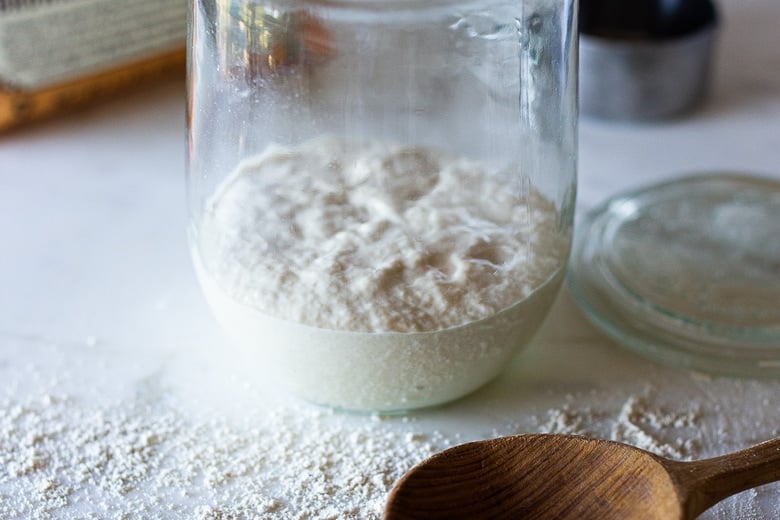
Day 2: After the first 24 hours, there may or may not be a bit of bubbling. Let the mixture rest until you see activity (bubbles or rising) sometimes this takes 36 hours or even 48 hours if very cold. When you see active bubbling, discard all but 1/2 cup of the starter (4 ounces).
To the remaining ½ cup of starter, stir in 1/2 cup water (120 grams), mixing well with a fork and 1 cup of organic bread flour (120 grams) spooned and leveled. Stir until combined. Again, it should feel like a thick paste. If overly dry, feel free to add a bit more water.
Cover again and allow the mixture to sit at room temperature for another 24 hours.
Day 3: After 24 hours, hopefully, you will see some bubbling or rising and if not, let it go a bit longer until you see activity. Be patient.
Depending on how warm your house is and how active your starter, you may need to begin feeding more often or move to two feedings a day, in the morning and at night.
In a nutshell, you want to feed the starter only after it has peaked (metabolized all the flour from the last feeding) and has started sinking down or gets liquidy- this is when it is hungry!
This might be 12 hours, it might be 14, it might be 18, or 24, depending on the temp in your house. In very warm climates it may only be 6-8 hours. In winter, this may take 36 hours. It is better to underfeed rather than overfeed here. For each feeding, like before, discard all but 1/2 cup of the STARTER (keeping roughly ½-cup of starter in the jar) Add 1 cup Bread Flour (spooned and leveled) and 1/2 cup water to the 1/2 cup starter and let this rest at room temperature for 12-24 hours or until the starter looks “hungry” again before repeating.
Day 4: Feed 1-2 times, discarding all but 1/2 cup of starter EACH TIME. Feed 1 cup bread flour, 1/2 cup water. Day four is typical for the starter slow down and stall a bit. This is OK. Just keep going, and look for the hunger signs, and only feed when clearly hungry. This may look like liquid on the top, or very runny starter (to the point where it can easily pour out of the jar). But hopefully, you’ll begin to see some rising and falling. It’s helpful to put the starter in a clean jar each day and mark the beginning level (with a sharpie, string or rubber band) so you can easily see this.
***If for some reason your starter looks like it is still rising at the time of second feeding (at night) and there is no evidence it has fallen or no slide marks, skip this feeding and feed first thing in the morning.
AGAIN, feeding it when it is “not hungry” will basically dilute all the growing yeast and make it lethargic. Better to starve than overfeed.
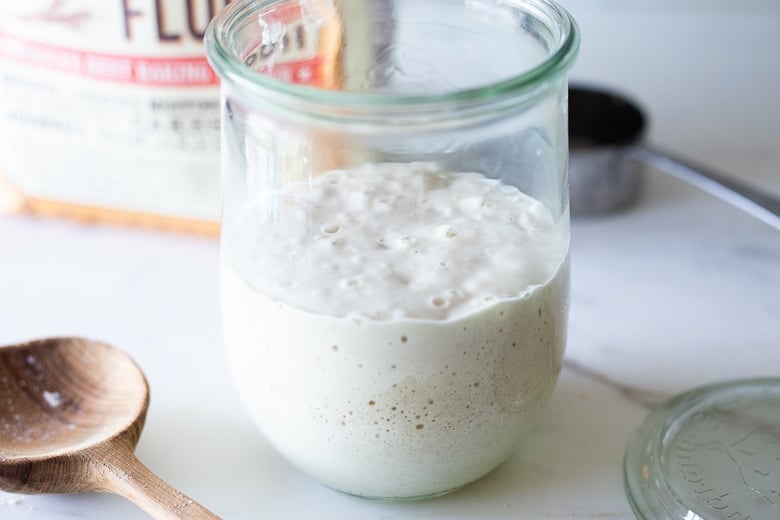
Above you’ll see it peaking, below you’ll see it deflating and getting “hungry”. Feed when the starter only when it’s hungry. This will can vary in time greatly – so even though there is a loose schedule laid out for you here, understand that your starter has a schedule of its own, it is a living thing- so watch it and pay attention!
I repeat: The key here is to watch it. Don’t feed the starter until it looks hungry. Overfeeding a starter makes it lethargic.
Look for the signs of “hunger”: You’ll see watery bubbles at the top or even a layer of liquid. See how below on the jar, how the starter slides down the side of the jar? Look for the “slide” marks just under the Weck logo.
If your starter is not rising and falling, look at consistency. As it metabolizes the flour and gets hungry, it will get runny and liquidy, like to the point where you can pour it right out of the jar. If it is still thick like paste, it’s not done metabolizing (eating)the flour.
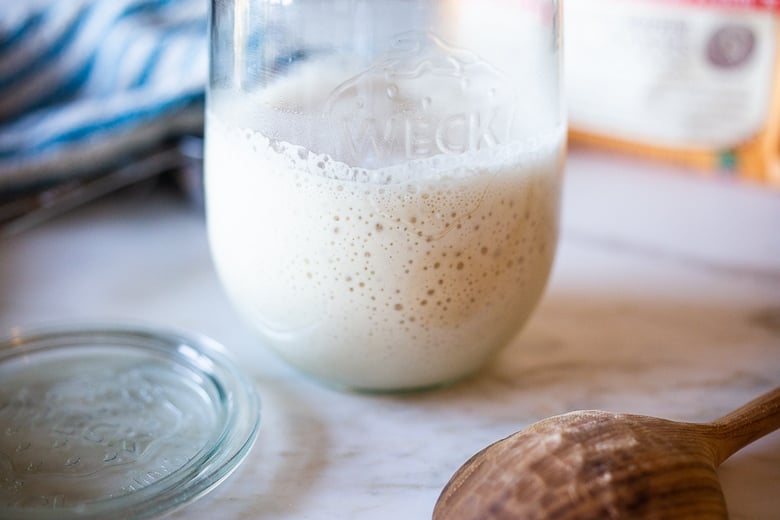
Day 5: Feed again, 1-2 times, roughly 12 hours apart, discarding all but a 1/2 cup the starter EACH TIME. 1 cup bread flour, 1/2 cup lukewarm water. The starter should look visibly active, bubbling, rising, hopefully, close to doubling in size.
You may need to repeat day 5 until the starter is rising and falling predictably and is close to doubling in size within 6-8 hours.
TIP: If your starter is not rising but there is evidence of hunger (liquid at the top) try 3 things: substitute 1/4 cup whole grain flour (add to ¾ cup white bread flour) on your next feeding. Try using mineral water like San Pellegrino instead of water. Stir the starter a couple hours after feeding to allow wild yeast from the room to get in there.
DAY 6: Baking day! Give it one last feeding in the morning. Discard all but a 1/3 cup. ( The reason we are changing this to 1/3 cup is to feed it a little bit more.) Add 1 cup flour (120 grams) and 1/2 cup water, and place it in a clean jar so you can see the action clearly. You can use a sharpie or place a rubber band around the jar to mark the beginning level. The starter should hopefully double in volume within 6 hours of feeding.
Then DO THE FLOAT TEST: To test the starter, place a teaspoon of starter (just from the top, don’t stir it down) in a glass full of water, it should hopefully float. If it does, you can make bread. Tonight! If it doubles in size but does not float, you can still give baking a try. Let the starter rest at room temperature for at least 8 hours allowing it to fully metabolize the flour, perhaps sinking a little before making your dough.
At this point, if your starter does not double in size within 6 hours of feeding, don’t give up! Often, it just takes longer, especially during the winter months. Continue feeding one to two times a day until you see a consistent, predictable rise and fall.
Read the troubleshooting section. If you need to take a break, put it in the fridge and try it again up to a week later. Don’t toss it.
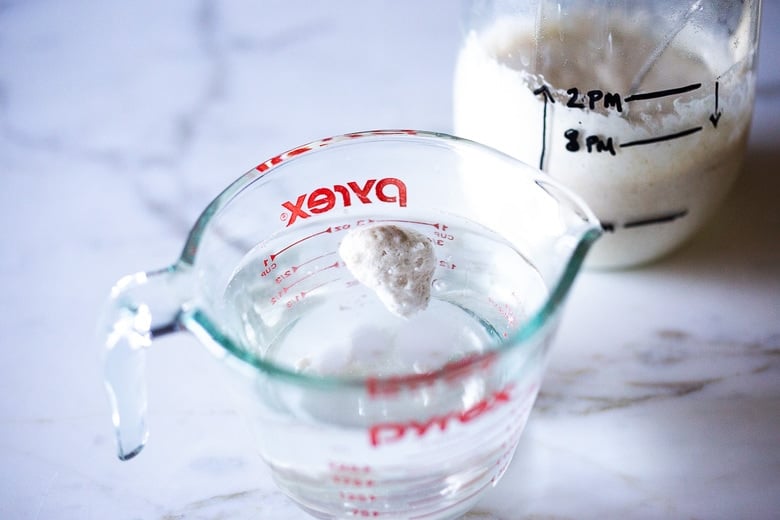
Day 6 EVENING: Use 1/3 cup to make this sourdough bread (if you want)and place the remaining starter (or if not making bread, place all of it) in the refrigerator, and feed it at least once a week, mixing in any liquid at the top, reserving ½ cup starter, before feeding it the usual 1 cup bread flour, 1/2 cup water.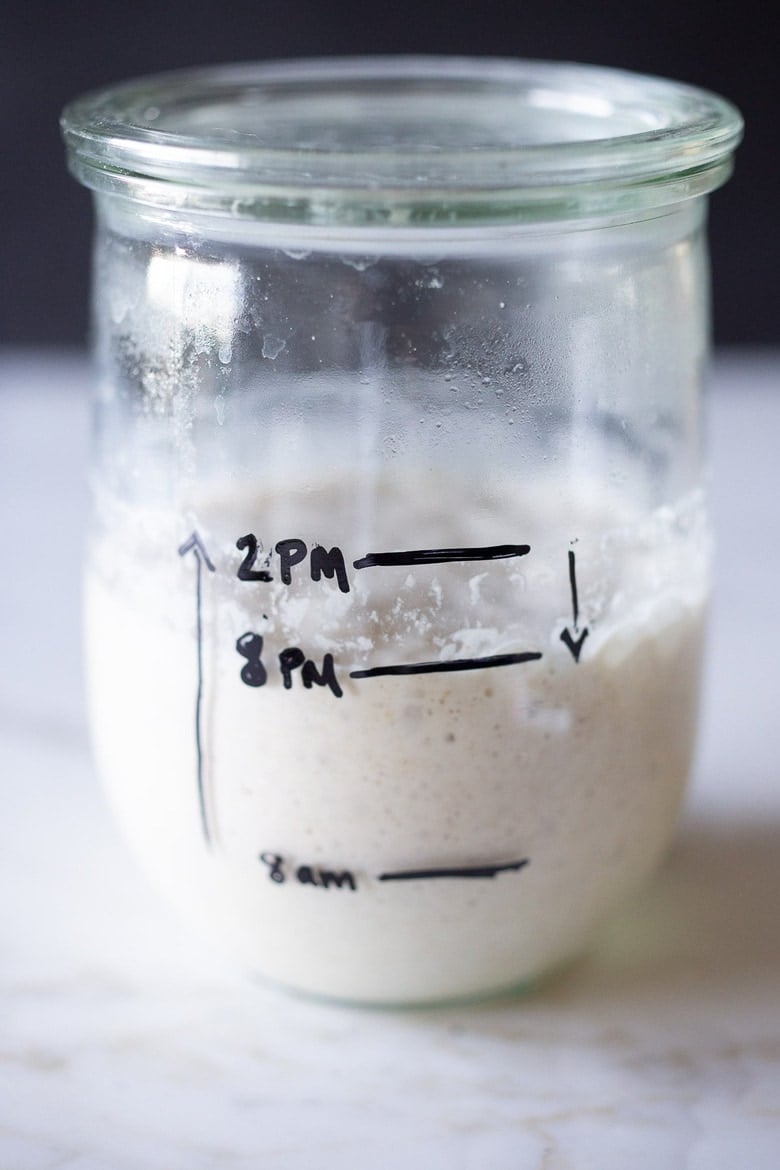
In the photo above, on the 6th day, the starter was fed at 8 am, it doubled at noon, but went even higher until around 2 pm where it peaked. Then as you can see, it started deflating and by 8 pm, it was lower, and “hungry” again. See those downward “slide” marks on the jar?
Look for these! That’s why it’s nice to put the starter in a clean jar so you can see these clearly. They tell you how high your starter went and that it peaked, and now is going down. Even at 8 pm, it passed the “float” test, so I started a loaf of my sourdough bread at this time.
TIP: When making bread, you want to use starter that has already peaked.
Signs of hunger:
- Slide marks (be sure to use a clean jar so you can see these clearly).
- A layer of liquid at the top of the starter
- The starter is thin and liquidy enough to pour out of the jar (when at room temp).
TROUBLESHOOTING:
- SMELL: Starter should smell sweet, tangy, earthy, like a wet horse – not “bad”. If it really smells foul or unpleasant, you may have used an unclean jar, unclean utensil, or somehow introduced other bad bacteria. I would start over.
- NO ACTION: On day 4-5 it is typically for it to slow down. If your starter is not rising at all but there is evidence of hunger (liquid at the top, or bubbles) try 3 things. First substitute 1/4 cup whole grain flour (add to ¾ cup white bread flour) on your next feeding. If no rise, then try using mineral water, specifically San Pellegrino instead of water. San Pelligrino specifically has the right mineral ratio, I have great luck with it. Others not so much! Also try stirring the starter a couple of hours after feeding, a couple of times throughout the day to allow wild yeast from the room to get in there. Lastly, you could try pineapple juice instead of water.
- FLOUR: Try to use fresh milled whole grain flour to start, then organic BREAD FLOUR. The more wild yeast in the flour, the better your starter will do- so smaller brands like Bob’s Red Mill seem to do better than bigger conventional brands that have been overly processed. It is totally OK to mix flours and to switch them up- this adds different kinds of wild yeast- a good thing!
- DO NOT overfeed. For example, maybe feeding 2 x day at 12-hour intervals is too often. You want to feed after the starter has peaked, then deflated (see photo above- you’ll see some slide marks on the jar) and this tells you that it is hungry. If you feed the starter before it has had a chance to metabolize (or eat) all the flour (before peaking) and then you discard part of it, and feed it again, you are actually diluting all that amazing bacteria, weakening your starter. So it’s all about watching your starter in your home. If you are not seeing rising and falling, but notice the starter just gets liquidy, this too is a sign of “hunger”. Or if it gets runny enough to pour out of the jar, another sign it is hungry. There are lots of variables here. Just be patient, pay attention and watch. This is a living thing- it doesn’t care about time schedules and recipes or what it “should” do. It will “eat” when it is “hungry” and sometimes it likes to eat slowly. 😉
- TIME: It may take longer than 6 days in colder environments. Use a kitchen thermometer and take its temp. Is it over 65F? Find a place where it can be warm. In the oven with the light on, or in an upper cupboard ( heat rises). Sometimes it takes 12-14 days! Be patient, keep going. If it is doing absolutely nothing, leave it out on the counter for 24-48 hours and see what happens. If you run out of flour or need a break, don’t just toss it, put it in the fridge and see if you can get it going a few days later.
- ACIDITY: If you still can’t get that starter going, some people recommend subbing pineapple juice for the water for one feeding- raising the acidity level. My good friend just tried this and it got hers going.
- LIQUID: If you see any liquid at the top of your starter, it means your starter is hungry. So, yes it’s still alive which is a good thing! You can stir the liquid in, or pour the liquid out, either way, but feed it. This is a sign that you may need to feed it more often.
- MOLD: if you see any discoloring or mold on the surface, starter was probably contaminated. If it is only on the surface, it is probably ok to save. Scrape it off, save 1/2 cup of the underneath starter, and keep going, using a clean jar. Feed, smell, use your best judgment.
- FLOAT TEST: Try testing when your starter is peaking. Take a spoonful from the top without stirring it down. If your starter is rising and falling consistently, but not passing the float test and it has been over 8-10 days- just try baking a loaf. People are having luck with good loaves without passing the float test. It may be the flour…
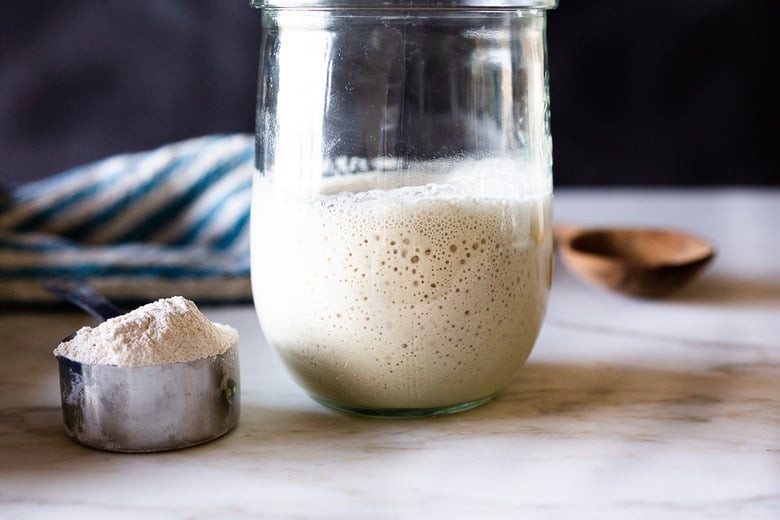
How to Maintain Your starter:
- REFRIGERATE & FEED AT LEAST ONCE A WEEK: Pick a scheduled day and try to stick with it, always reserving 1/2 cup and feeding it 1 cup flour and 1/2 cup water. Discard the remaining, give it away, or keep the discard in a separate container for waffles, pancakes, sourdough buns, banana bread, biscuits, etc. I usually don’t feed the discard unless I give it away.
- If you forget to feed it one week, it is most likely OK; feed it 1-2 times a day for 1-3 days in a row to revive it (keeping it out on the counter) until bubbly and active and doubles within 6 hours. I’ve left my starter for a month on vacation (in the fridge) without feeding and simply revived it by feeding it 3 days in a row, 1-2 x day. It’s surprisingly hard to kill. You can also freeze it for more extended storage.
- This batch will allow you to bake 2 loaves of bread per week with enough left to feed for the next week. If you find yourself wanting to bake more often, you can keep it out and feed it 1-2 x daily. Or if baking every few days, you can pull it out of the fridge, feed it 10 hours before using, leaving it out, use what you need while it is peaking (or slightly after), then put it back in the fridge that evening. Do the same thing a few days later when ready to use again. So this would be feeding 2-3 times a week, best if baking 4-5 times a week.
Tips on Sourdough Starter:
-
- TEMPERATURE: The colder your home, the longer it will take for the starter to grow and become active (bubbles). Find a warm spot (70-80 degrees) for the best results. On the stovetop, with the light turned on, or on top of the fridge. Or in the oven with the light on. On top of a heating pad (set to low) with a towel in between). You can still make the starter in a colder home, it will just take longer- even up to 2 weeks! Test the temp of your starter using a thermometer.
- FLOUR: Always try to start the batch by using organic whole-grain flour (wheat or rye) because it has more wild bacteria in it than white flour and will get it active and growing sooner. Freshly milled works exceptionally well. You can, of course, continue to use whole grain, but I just use organic white “bread” flour for days 2 through 6, less costly. You can also feed with organic all-purpose flour, but I’ve had much better luck with getting the starter stronger, faster, starting off with the wholegrain the first day, and using bread flour for the remaining. UP to YOU. You can always mix in a little whole grain with the white as well if your starter looks like it needs a boost.
- WATER: Sometimes chlorine in tap water can inhibit the growth of your starter. Some people leave tap water out, in an open container overnight to allow some of the chlorine to evaporate. Using lukewarm water helps fermentation to start faster. Try Mineral water, like Perrier, it seems to work wonders too! Sometimes bottled water can be overly sterile- so using mineral water (carbonated is OK) is a good option.
- HYDRATION: Hydration refers to the ratio of water to flour in terms of weight. It is a ratio. For starter, this is typically at 100% hydration. Meaning if you use 120 grams of water, use 120 grams of flour. This roughly translates to 1 heaping cup of flour and 1/2 cup water. Feel free to weigh instead of measure if you want to be more precise or want to familiarize yourself with the consistency. It’s nice to do this the first time to get a feel for it.
- STORING AND FEEDING: When your starter is kept cold, like in the fridge, you don’t need to feed it as often- only once a week. If you keep it out on the counter, you’ll need to feed it 2 x daily. Cold slows down the fermentation, and heat speeds it up.
- USING: When you need to use your starter for baking bread, feed it 4-8 hours before making bread dough, using it right at peak height or slightly after (even better).
- Do I REALLY have to discard my starter? YES. I know it seems wasteful- but while you are building your starter, during the first week, it is the simplest easiest, fastest and most economical way to create healthy a starter. This is because you always have to feed it 2 times its volume!!! If you keep the 1 1/2 cups starter, you would have to feed it 3 cups (instead of keeping just a 1/2 cup and only feeding it ONE cup). Get it? 😉 Doing this will shorten the fermentation process, require less flour in the long run, and create a stronger starter. Once the starter is “established” after the first week- then you don’t need to discard it but can use it in bread baking, pizza dough, scones, biscuits, waffles, sourdough buns, etc.,- or give it to a friend.
Signs of Hunger:

The photo above was taken after the starter was fed, peaked 4 hours later (reached its highest), and now is” hungry” again. The perfect time to use it in bread! See the downward slide marks on the jar. Again, pay attention to these- your starter is telling you what it needs. You just have to learn how to see it.
I hope you have fun with this simple little Sourdough project! In the coming weeks, I’ll put out some fun recipes to make with your sourdough starter! Also, watch the new step-by-step Sourdough Video above!
How to use your Sourdough Starter!
- No-Knead Sourdough Bread
- Sourdough Baguettes
- Sourdough Scones
- Sourdough Crackers
- Sourdough Biscuits
- Sourdough Buns
- Sourdough Tortillas!
- Vegan Banana Bread
- Overnight Sourdough Waffles
- Sourdough Pancakes
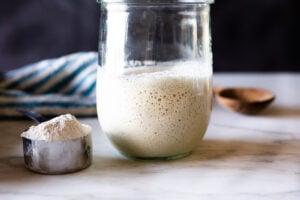
Simple Sourdough Starter
- Prep Time: 30
- Cook Time: 6 days
- Total Time: 144 hours 30 minutes
- Yield: 1 ½ cups 1x
- Category: sourdough, fermented, cultured, bread, baking,
- Method: fermented
- Cuisine: bread
- Diet: Vegan
Description
How to make your own Sourdough Starter (see the step-by-step video in post) using simple ingredients with no special equipment, in 6 days, that can be used in sourdough bread. Sourdough Starter is a wild yeast, made from fermenting flour and water.
Ingredients
- 120 grams whole grain flour (whole wheat flour, rye flour, or freshly milled flour) 1 cup, fluffed, spooned and leveled
- Organic White Bread Flour (5-10 lb bag ) I like Shepherd’s Grain or Bob’s Red Mill.
- 120 grams Water per feeding (1/2 cup water)
Instructions
-
- Day 1: Starting in the morning or at night, using a wide-mouth quart jar or Crock or Glass Measuring Cup mix 1 cup whole grain flour (120 grams) with 1/2 cup (120 grams) filtered water using a fork making sure you’ve incorporated all the dry flour. For your first measuring – it is a good idea to weigh the flour, using a kitchen scale so you get an idea of how thick it should feel. It should be like a thick paste. Thick like peanut butter. If you need to add a little more water to incorporate the flour, that is OK, but be precise with the flour. Place the lid on top (using the Weck jar is really handy here) or a damp towel to keep moisture in, or plastic wrap- and let sit at room temperature (70-80 degrees) on the kitchen counter for 24-48 hours, or until you see some bubbling. If you are not sure how warm it is, use a kitchen thermometer and check it a few hours later. See notes for TEMPERATURE.
- Day 2: After the first 24 hours, you may or may not see a bit of bubbling. I prefer to let this rest until I see a tiny bit of activity (bubbles) and sometimes this takes 36 or up to 48 hours. So start “day 2”, when you see a little bit of bubbing. Discard all but 1/2 cup (136 grams) of the starter. (See notes for discard). Add to the remainder, 1 cup of white bread flour, (120 grams), spooned and leveled, and 1/2 cup filtered water (120 grams), mixing well with a fork. Place the lid on loosely again and allow the mixture to sit at room temperature (70-80F) for another 24 hours.
- Day 3: By the third day, you should definitely see some bubbling- and if not, let it go a bit longer. Depending on how warm your house is and how active your starter, you may need to begin feeding more often, or even move to two feedings a day roughly 12 hours apart, like in the morning and at night. In a nutshell, you want to feed the starter only after it has peaked (metabolized all the flour from the last feeding) and has started sinking down or gets liquidy- this is when it is hungry! This might be 12 hours, it might be 14, it might be 18, or 24, depending on the temp in your house. In very warm climates it may only be 8 hours. It is better to underfeed rather than overfeed here. For each feeding, like before, discard all but 1/2 cup of the STARTER (keeping roughly ½-cup of starter in the jar -4 ounces or 136 grams) Add 1 cup Bread Flour (spooned and leveled) and 1/2 cup water to the 1/2 cup starter and let this rest at room temperature for 12-24 hours or until the starter looks “hungry” again before repeating.
- Day 4: Feed 1-2 times, discarding all but 1/2 cup of starter EACH TIME. Feed 1 cup bread flour, 1/2 cup water. Look for the hunger signs. Hopefully, you’ll begin to see some rising and falling. It’s helpful to put the starter in a clean jar and mark the beginning level (with sharpie, string or rubber band) so you can easily see this. ***If for some reason your starter looks like it is still rising at the time of second feeding (at night) and there is no evidence it has fallen or no slide marks, it is still “eating” so skip this feeding and feed first thing in the morning. AGAIN, Feeding it when it is “not hungry” will basically dilute all the growing yeast and make it lethargic. Better to starve than overfeed.
- Day 5: Feed again, 1-2 times, roughly 12 hours apart, or when hungry, discarding all but a 1/2 cup the starter EACH TIME. 1 cup bread flour, 1/2 cup lukewarm water. The starter should look active, bubbling, rising, sliding down, hopefully, close to doubling in size. (If not, repeat this day until starter doubles in size within 8-12 hours of feeding- and read the troubleshooting section.)
- DAY 6: Give it one last feeding. Discard all but a 1/3 cup. Add 1 cup flour ( 120 grams) and 1/2 cup water, and place it in a clean jar so you can see the action clearly. You can use a sharpie or place a rubber band around the jar to mark the beginning level. The starter should hopefully double in volume within 6 hours of feeding. When it peaks, DO THE FLOAT TEST: To test the starter, place a teaspoon of starter (just from the top, while it is peaking, don’t stir it down) in a glass full of water, it should hopefully float. If it does, you can make sourdough bread. Tonight! Let the starter keep resting at room temperature or a few more hours allowing it to fully metabolize the flour, perhaps sinking a little before making your dough. You want to make dough with slightly hungry starter. Place the remaining starter in the fridge and feed it in a week. You’ll have enough stater to make one more sourdough loaf during the week, and still have enough to feed. If you want to wait to make bread until later in the week place starter in the fridge. Be sure to feed it in 7 days. Read maintenance section.
- At this point, if your starter does not double in size don’t give up! Often it just takes longer, sometimes up to two weeks, especially if it’s cold. Continue feeding one-two times a day (only when hungry) for a few more days, until you see a visible rise and fall. Read the troubleshooting section. If you need to take a break, just put it in the fridge and try it again up to a week later. Don’t toss it- if there are bubbles, it is still alive.
- This batch of starter will make two loaves of bread with enough left over to feed for the following week.
TROUBLESHOOTING:
- STALLING: It is typical to see a “stall” on day 4 or 5. If your starter is not rising but there is evidence of hunger (liquid at the top) try 3 things: substitute 1/4 cup whole grain flour (add to ¾ cup white bread flour) on your next feeding. Try using mineral water like San Pellegrino instead of water. Stir the starter a couple hours after feeding to allow wild yeast from the room to get in there.
- SMELL: Starter should smell slightly sweet and tangy, and not off or “bad”. To me, it smells like a wet horse;) If it smells VERY unpleasant, you may have used an unclean jar, or an unclean utensil, or somehow introduced another foreign bacteria. I would start over.
- TOO MUCH ACTION: if your starter overflows from the jar, this is a good sign,(not bad) it is alive and active. This often happens in warm climates. You’ll need to feed it more often or find a cooler spot. Even if it floats on day 2-3, please keep feeding it the full 6 days before using it to make bread. It will add more flavor and complexity.
- CONSISTENCY: Thick or Thin? If you have been careful about measuring feedings, but are not seeing rising or falling, another way to tell what stage of your starter is in is to look at the consistency. If the starter seems really thick, it is still “digesting”. If it seems loose or runny or liquidy, (to the point where you can pour it out of the jar) it has digested all the flour and is now “hungry”. It loosens up as it metabolizes the flour. So even if you don’t see rising or falling, look for consistency to give you clues.
- DO NOT overfeed. For example, maybe, feeding 2 x day at 12-hour intervals is too often. You want to feed after the starter has peaked, then deflated a little or is runny (see photo above- you’ll see some slide marks on the jar) and this tells you that it is hungry. If you feed the starter before it has had a chance to metabolize (or eat) all the flour and then you discard part, and feed it again, you are actually diluting all that amazing yeast. Get it? So it’s all about watching your starter in your home. There are lots of variables here. Just be patient, pay attention and watch. This is a living thing- it doesn’t care about time schedules and recipes or what it “should” do. It will “eat” when it is “hungry” and sometimes it likes to eat slowly.
- It may take longer than 6 days in colder environments. Use a kitchen thermometer and take its temp. Is it under 65F? Find a place where it can be warm. Or use lukewarm water when mixing. Place it in the oven with the light on overnight. (Not in direct sunlight) or above the fridge, or on the stovetop. Sometimes if cold, it takes 10-12 days. Be patient, keep going. If it is doing absolutely nothing, leave it out on the counter for 24-48 hours and see what happens. If you see bubbles, it is alive and can be coaxed. If you run out of flour or need a break, don’t just toss it, put it in the fridge and see if you can get it going a few days or up to a week or two later.
- ACIDITY: If you still can’t get that starter going, some people recommend subbing pineapple juice for the water for one feeding- raising the acidity level. My good friend just tried this and it got hers going.
- LIQUID: If you see any liquid at the top of your starter, it means your starter is hungry. So, yes it’s still alive which is a good thing! You can stir the liquid in, or pour the liquid out, either way, but feed it! This may be a sign that you may need to feed it more often than you are.
- MOLD: if you see any discoloring or mold on the surface, the starter was probably contaminated. If it is only on the surface, you could salvage it. Scrape it off, save 1/2 cup of the underneath starter, and keep going. Feed, smell, use your best judgment.
- FLOAT TEST: If your starter is consistently rising and falling and it is has been over 8 days, but still doesn’t pass the float test, try baking a loaf of bread anyway. Remember, use hungry starter when mixing up the dough.
MAINTENANCE:
- REFRIGERATE & FEED AT LEAST ONCE A WEEK: Pick a scheduled day and try to stick with it, always reserving 1/2 cup starter (130 grams) and feeding it 1 cup flour (120 grams) and 1/2 cup water (120 grams). Discard the remaining, or give it away, or keep the discard in a separate container to use in waffles, pancakes, sourdough buns, banana bread, biscuits, etc. I usually don’t feed the discard unless giving away.
- If you forget to feed it one or two weeks in a row, it is most likely OK, just feed it 1-2 x day for 1-2 days in a row to revive it (keeping it out on the counter) until bubbly and active. I’ve left my starter for a month on vacation (in the fridge) without feeding and simply revived it by feeding it 3 days in a row, 2 x day. It’s actually kind of hard to kill. You can also freeze it for longer storage.
- If you find yourself wanting to bake more often than once a week, you can keep it out and feed it 1-2 times daily. Or if baking every few days, you can pull it out of the fridge, feed it 8-10 hours before using, leaving it out, use what you need while it is peaking, then put it back in the fridge that evening. Do the same thing a few days later when ready to use it again. So this would be feeding 2-3 times a week, best if baking 2-3 times a week.
Notes
- TEMPERATURE: The colder your home, the longer it will take for the starter to grow and become active (bubbles). Find a warm spot (70-80 degrees) for the best results. On the stovetop, with the light turned on, or on top of the fridge. Or in the oven with the light on. On top of a heating pad (set to low) with a towel in between). You can still make the starter in a colder home, it will just take longer- even up to 2 weeks.
- FLOUR: Always try to start the batch by using organic, freshly milled whole-grain flour (wheat or rye) because it has more wild yeast in it than All-Purpose or white flour and will get it active and growing sooner. You can, of course, continue to use whole grain, but I’ve had the best luck using organic “bread” flour for days 2 through 6. People have made a sourdough starter with All-Purpose flour- but personally, this has never worked for me– there are fewer nutrients and wild yeasts in the flour and results in a very lethargic starter. If it is your only option, try mixing in 2+ tablespoons of whole-grain (wheat or rye) with the AP flour per feeding. Feel free to use different flours or mix different flours together. It is OK to use all-purpose flour if in a pinch, but using it repeatedly will result in sad starter.
- WATER: I usually use tap water -but sometimes the chlorine in tap water can inhibit the growth of your starter. Lukewarm water helps fermentation to start faster. Sterilized bottled water is often overly sterile, and can also inhibit. Mineral water, like Perrier (carbonated is OK) can sometimes work miracles.
- HYDRATION: Hydration refers to the ratio of water to flour in terms of weight. It is a ratio. The starter is typically at 100% hydration- meaning equal parts flour and water, in terms of weight. So if you use 120 grams of water, use 120 grams of flour. This roughly translates to 1 cup of flour and 1/2 cup water. Feel free to weigh instead of measure if you want to be more precise, or want to familiarize yourself with the consistency you are aiming for. If using whole grain flours (which tend to be “thirstier”) and your starter seems very thick, it is totally OK to add more water to thin it a bit. I intentionally keep the hydration a little lower here (a thicker starter) so you can more clearly see the rise and fall “action” in the jar.
- STORING AND FEEDING: When your starter is kept cold, in the fridge, you don’t need to feed it as often- only once a week. Feel free to feed it “cold”, and put it right back in the fridge if you like. If you keep it out on the counter, you’ll likely need to feed it 1-2 x daily (or just watch and feed only when hungry). Cold slows down the fermentation, heat speeds it up.
- USING: When you need to use your starter for baking bread, feed it 10-12 hours before making bread dough, using it after its peak height. For a more “sour” flavored bread, use the starter straight from the fridge, 3-6 days after feeding. The starter gets more sour tasting the longer it goes without feeding. Feeding the starter the same day as making bread will produce a milder sourdough flavor.
- Do I REALLY have to discard my starter? BASICALLY YES. I know it seems wasteful- but while you are building your starter, during the first week, it is the simplest, easiest, fastest, and most economical way to create healthy a starter. (Or save it separately -in the fridge- and use it in Pancakes, Waffles, Buns, or Biscuits. ) This is because you always have to feed it 2 times its volume in flour. For example-if you kept all the 1 1/2 cups of starter, you would have to feed it 3 cups of flour (instead of keeping just a 1/2 cup and only feeding it ONE cup). Doing this will shorten the fermentation process, require less flour in the long run, and create a stronger starter. Once your starter is “established” after the first week- then you can give it away to friends, use it in pizza dough, banana bread, waffles, pancakes, buns, etc) or give it to a friend. If you would like to save your “discard” during the first week – use it as you would flour and water, not expecting any rise.
- HOW TO USE YOUR SOURDOUGH STARTER/Discard :
- No-Knead Overnight Sourdough Bread (only if it passes the two “tests”)
- Overnight Sourdough Waffles
- Sourdough Pancakes
- Sourdough Scones
- Sourdough Biscuits
- No-Knead Sourdough Bread – only after day 6
- Vegan Banana Bread
- Sourdough buns
Save the sourdough “discard” in a separate container in the fridge.
Nutrition
- Serving Size: 1 tablespoon
- Calories: 31
- Sugar: 0 g
- Sodium: 0.2 mg
- Fat: 0.1 g
- Saturated Fat: 0 g
- Trans Fat:
- Carbohydrates: 6.2 g
- Fiber: 0.2 g
- Protein: 1 g
- Cholesterol: 0 mg


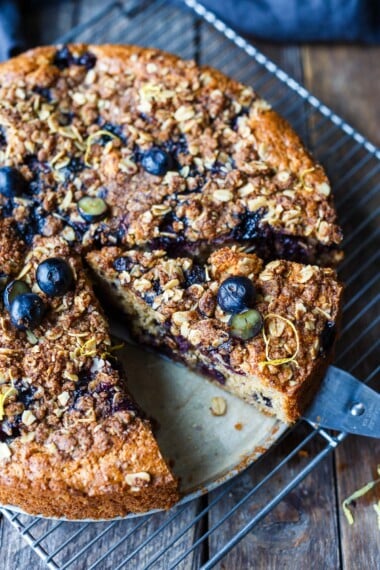




I am on day 4 of building my starter. When I first began the process on day 1, I tried to create a very warm environment for my starter to sit in by heating up my microwave with a glass of water , taking out the glass of water and discarding it and then putting the starter in the preheated microwave. To be clear, I did not microwave the starter mix which I had in a 24 oz glass jar with Saran Wrap lightly on top. Using this process, on day 1, the starter was very active and very bubbly with lots of holes and doubling in size. It never fell, but at the appointed times when I was to feed the starter, it had a very intense smell. I thought maybe I was a little too aggressive with my and was concerned about creating a mold environment, so stopped putting it in a preheated microwave and left it on my counter wrapped in a towel beginning with day 2. Ever since I have been just leaving it on the counter, it does not get high and bubbly and does not show evidence of rising and falling oh, but it is quite liquidy, so I have been following your schedule and I’m now up to two feedings a day. My concern is that I jump-started the fermentation process, and then stopped doing it and now my starter is protesting, LOL. I guess time will tell by the 6th day and a float test whether or not I was successful. What do you think of my amended process using the preheated microwave as a proofing chamber initially?
Mimi- If it is very cold there, it may be a good option for added warmth. For now, I would just keep going, feeding only when hungry/ runny. It may not sink down like my photos- that is ok, main thing is it doubling within 6 hours of feeding on the 6th day? If so then you should be good to go.
I’m on my 4th day it has quadrupled in size lots of bubbles. However, it is not sliding down. It has liquid on top. I fed last night then again in 12 hours. Is it hungry?
Hi Teresa! If there is liquid, then it is hungry. If it is not sliding down, check to see it if pours out of the jar easily, that is another sign of hunger. Better to wait than overfeed. 😉
Hi, Sylvia 🙂
My starter is a few months old now, I’m keeping it in the fridge. I’ve been feeding when I’m baking with 120 g water and 120 g flour, but I want to have more starter. Should I increase my feedings? How much flour and water should I add?:) One more question: my starter is quite runny but bubbly and active and smells nice. It also passes the float test when baking, but I wonder if the runny consistency is ok?
Hi Beatrice! It may be runny because it is a little hungry. To make more starter, just save double the amount and feed double the amount. Hopefully that makes sense. 😉
Yeah, that makes sense, thank you!!
Thank you for your help.
Hi Sylvia, I’m on day 4 (it’s winter where I am). It was bubbling yesterday and this morning but no sign of rise and fall so I left it hungry for more than 36 hours. Just then I saw white mould growing on the surface. I managed to scrape it off. Would this work?
Oh shoot. If you think you got most of it, and you are comfortable you could keep going? I wonder if it is too warm?
Hi
I’ve realised I’ve put.my dough starter in a clip seal Mason jar. Is this too air tight. Should I leave the jar unclipped? Its been 24 hours and not much movement but I’m in the UK and it’s a bit cooler at the moment.
Thank you
Ellie
I would leave it unclipped, but it probably didn’t hurt your starter so just keep going. 🙂
Thank you so much for taking the time to reply. I removed the rubber seal and have left unclipped. It’s starting to rise now. 🙂
Oh good Ellie!
Good morning. I have gone on to day 2 but accidentally added too much water (1 c. instead of 1/2 c.). Is this a problem? It didn’t seem like it was a warning to stay away from in your instructions, but I figured I’d ask. Thanks!
I think it could be ok. It may take a little longer if you want to continue with this batch. At next feeding, I would Save 3/4 cup starter and feed normal amount, when it gets hungry. Then go back to feeding 1/2 cup?
Hey, just wondering if my last message was still processing?
Yup, answered below. 😉
I am on Day 2, using Rye wheat. When I woke up this morning my starter was triple the size.( I live in a tropical climate) I didn’t wait for it to deflate, I poked it with a fork and it dropped & I carried on with the instructions.. I am guessing if in 12 hours she is hungry again I should feed her?
(When I discarded the rest , it floated !!)
Now, another question, I only have coconut flour, regular flour & the rye. Do you think I should continue with rye or can I use one of the others? Rye here is expensive & I don’t exactly want to be using it for discard ):
Many thanks! Can’t wait to see what happens !
* I did have to add more water like you said because the starter was not looking like the constancy you mentioned.
It sounds happy!I’d try using 3/4 regular flour mixed with a 1/4 rye. 🙂
I am on day 3 of making my starter following your recipe. So far, I have saved the discard to make new starters in two different jars (so I basically have 3 starters going). I’m doing this to give away to 2 of my sisters who want one. I read somewhere in your directions that the stage where you could give away the starter is at the end when the starter is established, but if I have been saving the 1/2 cup of starter and feeding it separately in the 3 jars, is this ok?
Yes, this is fine Kris! Just make sure the starter you give away is at least 6 days old and doubles in size within 6 hours of feeding.
I made the sour dough starter, as per your instructions on the video, and after 6 days, it is ready. It looks just like you said and it passed the float test. Thank you so much for giving the instructions and video. I am so excited to make my first loaf of sourdough bread. I have always been intimidated about starting one but I am so glad I did. I will be trying your recipes. Thank you so much..
Great to hear Laurel!
Thank you so much for this detailed fool-proof recipe! I have tried making sourdough starter before, without much success. I gave it another chance and it paid off! This recipe worked so well!
I fed the starter with whole-grain flour only because with the bread flour it took very long to rise and I was getting impatient. ‘:D. This seemed to have helped my starter double in size in the expected time. I guess it’s because summer hasn’t reached England yet. 🙂 Anyway, I wouldn’t have thought of that without your brilliant recipe, so thank you, thank you, thank you!
I now enjoy freshly baked sourdough loaves every week, using your amazing no-knead sourdough bread recipe.
So happy that you gave it another go and had success! Congrats!
You said to start with whole grain flour so why was it Snow White ?
I used a lite rye.
Thanks so much for the detailed instructions. I have been following your instructions to a tee. I started Friday night with making my starter, 24 hours later–Saturday night, I fed it with bread flour and discarded part of the starter like you suggested. On Sunday morning it doubled/tripled in size (as evidenced by the skid marks I saw), I fed it Sunday night with bread flour (little bit of rye mixed in). Monday morning I noticed no change in the starter, very few bubbles (like three small bubbles), no signs of it rising and fed it. Monday night, went to feed the starter and had only a few bubbles, had shown no signs of rising, and fed it again with bread flour/mixed in rye. This morning, has a few bubbles (like 2-3), has still shown no signs of rising, so just skipped feeding it. I don’t know what to do. I have watched your videos and read your instructions. Basically I feel like since I got a TON of activity on day 2…it has continued to show few bubbles, no signs of rising, etc. It has the consistency your starter has when I go to feed it typically, but other than that, lacks bubbles and activity. Thoughts on what to do? Wonder if its lethargic and I need to let it digest longer. I checked the temp of where I have it stored and its 78 degrees F, I am feeding it with filtered water too.
When it gets to the point of liquid on the top, or you are able to pour it out of the jar, feed it. 🙂 Wait until then.
I love the rounded jars with the glass lid! Where can I get some of these.
They are Weck jars and linked in the post. 🙂
Hi there! I have tried this a few times and on the second day (after I add the bread flour) my starter gets huge in a matter of about 6 hours. After feeding it on day 3 I see very little action, some bubbling at the top but that is about it. I can never seem to get it going again after the feeding on the 3rd day. I have tried skipping feedings here and there but no luck. Any advice?
this is fairly typical. You just have to press on through and be patient. Try mixing in a little whole grain flour, and only feed when hungry. 🙂
I have tried making this several times and my starter always turns out much thicker then yours when I make it. I am measuring 120 grams for both water and flour. I can’t figure this out.
Hi Mark- what kind of flour are you using?
Hello Sylvia,
I am using the King Arthur whole grain whole wheat flour. 120 g of water and 120 g of flour. I’m keeping my starters in a room where it’s about 74°. They’ve been sitting now for about 12 hours and the only change is a little bit of liquid sitting on top of them no bubbles at all. I just can’t understand what my problem is.
Ok, so it is very thick w/ no rise at all, but liquid at the top after 12 hours? Does it pour out of the jar after 12 hours? Do you have another flour, like white bread flour you could try using at the next feeding?
Okay after 48 hours it is bubbling like crazy and is ready to eat, guess it just took an extra day to get going. We will see how it goes from here! Thank you for the quick responses.
Great Mark!
After letting my starting sit for 48 hours it’s off like gangbusters! I have hungry starter! Feeding it with organic bread flour and will se how it progresses.
Thank you!
I am starting to stress out about this project. Lol. Not even sure what day I am on, since I have been extending the time due to lack of growth. It def bubbles. Grows maybe an inch? Yes it pours out but I have never seen it double. I may be on day 7 or 8. I stopped feeling it every 12 hours. Yesterday when I added more flour and water, it grew an inch within 5 hours and has done nothing since. What do I do?
Hi Cathy- don’t stress! It is growing so you are definitely on the right track. 🙂 I would just keep going and perhaps play with different a flour? What flour are you using? You can try mixing in a little whole grain? Don’t watch the clock just watch the starter. It is alive, active and now it may take a little time to get it stronger.
Ok, well I tried whole wheat after plain white didn’t seem to produce double. To be honest, I have done nothing to it since Tuesday night. I just wasn’t sure what to do. It grew a bit and then stopped. I still see bubbles in there. What next? Is it too late to feed it since it has been 3 days???😬
Nope, just keep going. If there are bubbles, it is still alive Cathy. It is most likely the flour- freshly milled flour has the most wild yeast, and whole wheat is a step up from white. Organic flours work great too. Mixing flours is a good option.
Hello. Is it possible for a starter to be ready to bake within the first few days of creating the starter? After the first 24 hours, she is bubbling like crazy and doubled in size! 6 hours later (after feeding her), she’s doubled in size again! I’ve created starters before, and each time it took about a week, but this time it’s unbelievable! I’m using half whole wheat and half all purpose flour. Do you think I could bake already on the 3rd day?
Hi Amy- it is a great question and I’ve personally never tried baking so early, so I’m not 100% sure. Everything that I have read and researched says to wait-so I tend towards that, but it is up to you.
I love you recipes! I do think that I may have messed up my starter that I’ve been using since 10/15/20… lol I have been feeding it with whole wheat flour and it is pretty dark…I missed the part about switching over to bread flour. Everyone loves my bread though, maybe because it’s free, but should I start to use bread flour now or just start over?
Second question…I live in south Florida and I have been letting my starter sit in the lanai after I feed it and it peaks pretty quickly and it seems like it helps my dough as well instead of leaving it inside. It is about 80-85 degrees in high humidity. My loaves come out a little flatter than I care for, is this a bad idea and the reason for the flatter loaves? Thank you!
Hi Ted, whole wheat is fine and sounds like it is working for you no need to change. I wonder if your bread dough though is over proofing slightly? Perhaps try shortening the proofing time?
Hi Sylvia, I’m in need of some guidance. I’ve been using a mix of whole wheat organic flour and bread flour and things were going great day 1-3 (the starter was doubling in size on day 3) but suddenly on day 4 it stopped and I’m seeing almost no action except for 3 very small bubbles on top. The consistency is very sticky and wet and has not risen at all in 3 days. I’m afraid I fed it too early with both feedings on days 4 & 5 and have now weakened it. Like you suggested, I’ve left it out for 48 hours but I’m still not noticing any increased activity. What would you recommend I do? Should I discard and start from scratch? I’m so devastated.
Is it liquidy? Does it pour out of the jar?
Hi, just completed the 6 day preparation and my first loaf turned out amazing!
So, I used the first batch of starter and put my jar in the fridge. Was I supposed to feed it again? Or do I take it out, feed it, then use what I need after it peaks again. (Will it peak after being refrigerated?) I’m just confused!
I would like to make another loaf this week, but want to be sure I have enough to maintain the starter.
You should still have enough to make one more loaf and feed the remaining starter for next time. Or if you are worried you could feed in the morning before you make the dough ( leave it out on the counter), let it peak before using for the dough.
Thanks Sylvia, So far so good for me.
Thanks Sylvia,
So far so good for me. I’m also a bit confused about what to do today on day 6. If my starter passes the float test – and I’m not planning on making bread today – do I put the jar in the fridge without feeding? And then just feed it in a week? Or, do I feed it after the float test and put it in the fridge right after the feed?
Thanks for your time!
Yes, you can put it in the fridge without feeding. Actually either way would work fine;)
Hi sylvia I followed all the thing you mentioned in this post . My starter is doubling in 24 hours after that I fed it and it tripled in even 6 hours and started to slide down . As you instructed I fed it because I saw it was hungry after this feeding which was in day3 there is no rise at all just small bubbles on top which after some hours I can just see lots of dark water on top also as I am using bakery flour the color of starter is amazing at the beginning its like the beautiful starter pictures on web while it is rising but in day 3 the color is also change to a cream floury color. I tried it for one month and each time I face the same situation and I get disappointed and through them . Please kindly guide me I was so eager and now I am very disappointed.
I would try different flour. Organic bread flour is preferred here- and you could try mixing in a whole grain at times. Freshly milled flours are the BEST.
Hi, Sylvia:)
I’m almost done making the starter, I’m on day 6. Fed it in the morning after 12 hour gap, the starter doubled in sized after approx. 4 hours. I guess this is a good sign. I’m thinking I should feed it again after 12 hours and not make bread yet, since the starter started peaking and falling consistently just recently, because of the weather I think. Should I feed it one more day and make bread tomorrow evening? 🙂
yes, feed it again today, and make dough tonight after it peaks!
The bread turned great, but not perfect. Still good with peanut butter! Maybe needed to prove longer 🙂 I will try to experiment with different flours. One more question: how should I store the starter in a fridge: tightly closed or just covered with a cloth?
I just place a lid on top and turn once- not tight!
Hi Sylvia…..
Love your flawless directions, and I’m trying really hard to get this right. All was going well, but then it didn’t rise after day three feeding (weather was consistent). I switched to part whole grain, and it did better, but have never managed to get to two feedings a day. And today on day 8, it rose and rose and rose some more from 10pm the night before. At 6pm I tried a float test. It didn’t sink but just spread out like a scum. Once the starter had been disturbed by the spoon, it dropped, so I’ve fed it and left it again. Any thoughts? Many thanks
It sounds ok to me! Just see if it doubles within 6 hours of feeding.
Hi, Sylvia! My Day 1 took almost 36 hours because of the temp in my home, which was fine. Day 2 it almost doubled after only 5 hours (from 5pm to 10pm), so I left it over night and fed it in the morning when I saw there was evidence of more rising and a downward slide. I fed it and after over 12 hours it hadn’t risen at all, but there were lots of watery bubbles at the surface and it had become very thin. Based on what I read in your post, I fed it anyway since it was thin and bubbly. This morning (12 hours later), it’s the same situation— there are some bubbles breaking the surface and it’s thinner but no rise.
Do I leave it longer and try to see if it will rise? It seemed like it was off to such a great start on day 2 and now I’m worried I somehow killed whatever yeast was growing. I followed all of your ingredients and weights exactly so far. Thanks!
It seems fairly typical. If you can easily pour it out of the jar, I would feed and just keep going. 😉